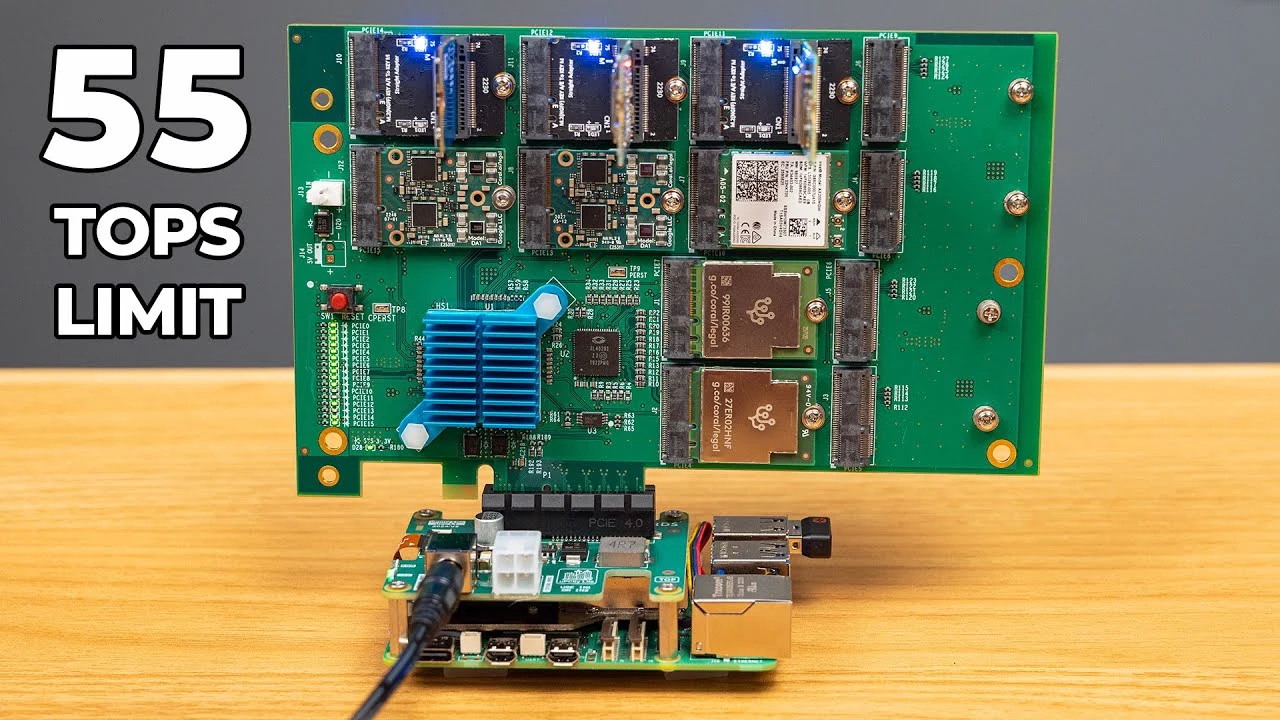In a remarkable feat of DIY engineering, Jeff Geerling has modified a Raspberry Pi 5 transforming it into a mini PC powerhouse, boasting an impressive 55 TOPS (Tera Operations Per Second) of AI computing power. This interesting project showcases the potential of leveraging multiple neural processors to enhance the capabilities of compact, single-board computers. However, this ambitious project also highlights the challenges that arise when pushing the boundaries of hardware and software integration.
The foundation of this mini PC is the Raspberry Pi 5, a compact yet powerful board known for its versatility and affordability. To unlock its full potential, the Raspberry Pi 5 is enhanced with Pine board’s UPiCty, an innovative solution that provides additional PCI Express slots. These slots are crucial for connecting multiple neural processors, which significantly boost the AI computing power of the setup.
The ALEL PCI Express 12-slot expansion board is then integrated into the system, allowing for the connection of several Coral TPUs and Halo NPUs. These neural processors are the heart of the AI computing capabilities, allowing the mini PC to tackle complex tasks and process vast amounts of data efficiently.
Raspberry Pi Equipped with 8 Neural Processors
Here are some other articles you may find of interest on the subject of Raspberry Pi 5
Power Supply Challenges: Keeping the System Stable
With great power comes great responsibility, and in this case, it also comes with increased power requirements. Powering this advanced configuration demands more than the standard supply provided by the Raspberry Pi 5. To ensure stable operation, an additional 12V power supply is necessary.
Monitoring power consumption becomes essential to avoid potential overloads and maintain system stability. This is achieved using a Third Reality smart outlet, a device that allows for real-time tracking of power usage. Combined with Home Assistant software, this setup enables effective power management and helps prevent any power-related issues.
- Additional 12V power supply required for stable operation
- Third Reality smart outlet used for monitoring power consumption
- Home Assistant software helps track power usage and avoid overloads
Software Challenges: Navigating Compatibility and Limitations
Configuring the software to support this complex hardware setup presents its own set of challenges. One of the initial hurdles is allowing Message Signaled Interrupts (MSI), which are essential for efficient communication between the neural processors and the Raspberry Pi. Detailed guides and documentation prove invaluable in successfully configuring the Coral TPUs and ensuring smooth operation.
To further enhance hardware compatibility, Pine boards hat AI overlay is used. This software layer helps bridge the gap between the various components and ensures seamless integration. However, despite these efforts, software limitations become apparent when attempting to run multiple TPUs simultaneously. This requires careful troubleshooting and highlights the need for improved software support for multi-processor setups.
- Allowing Message Signaled Interrupts (MSI) is crucial for efficient processor communication
- Detailed guides assist in configuring Coral TPUs successfully
- Pine boards hat AI overlay enhances hardware compatibility
- Software limitations arise when running multiple TPUs simultaneously
Performance and Usability: Balancing Power and Practicality
With the hardware and software components in place, this modified Raspberry Pi 5 mini PC achieves a remarkable 55 TOPS of neural compute power. This level of performance opens up new possibilities for AI applications and data processing on a compact scale.
However, it’s important to note that the single PCI Express Gen 2 lane used in this setup may limit data transfer speeds, potentially creating a bottleneck in performance. While there is room for further expansion by adding more TPUs and NPUs, the current software support for multiple neural processors remains inadequate, affecting the overall usability of the setup.
Future Considerations: Refining the AI Computing Experience
Looking ahead, improved software support for multiple neural processors is crucial to unlocking the full potential of this mini PC configuration. Better integration between hardware and software components could lead to even higher performance levels and enhanced stability.
For practical applications, it may be worth considering a more streamlined setup with fewer devices. This simplification could improve reliability and ease of use, making the mini PC more accessible to a wider range of users.
While this project showcases the exciting possibilities of DIY AI computing, it also serves as a reminder of the complexities involved in pushing the boundaries of technology. It highlights the need for continued development and refinement in both hardware and software to create more user-friendly and efficient AI computing solutions.
Conclusion: A Glimpse into the Future of DIY AI Computing
The modified Raspberry Pi 5 mini PC, with its impressive 55 TOPS of AI computing power, stands as a testament to the ingenuity and determination of DIY enthusiasts. While it comes with its own set of challenges and complexities, this project offers a glimpse into the future of AI computing on compact, affordable platforms.
As software support improves and hardware integration becomes more seamless, we can expect to see more accessible and powerful AI computing solutions emerge. This project serves as an inspiration for those who dare to push the limits of technology and explore the exciting possibilities that lie ahead.
Video Credit: Jeff Geerling
Filed Under: DIY Projects, Hardware, Top News
Latest TechMehow Deals
Disclosure: Some of our articles include affiliate links. If you buy something through one of these links, TechMehow may earn an affiliate commission. Learn about our Disclosure Policy.
